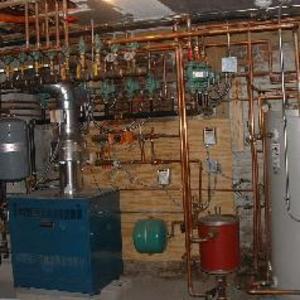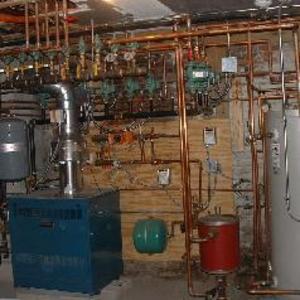Can I Repair My Taco Circulator Pump? The answer is yes. This home improvement job requires few tools and just a little insight to accomplish. Heating systems in general are expensive to maintain. Any service that a homeowner can perform on their own can save hundreds, if not thousands of dollars in labor costs.
Taco circulators truly are the work horse of the hot water heating system. They do all the work. Moving water that is heated by the boiler and circulating it to the remote radiation throughout the system. These pumps are in continuous on and off operation and eventually they will break down.
When a pump develops a leak at a flange, it should be repaired immediately. Leaving a leaking condition will rot out non ferrous metals rapidly. This includes your boiler as well as the pumps.
When you have a leak in a hot water heating system, the new water that is added by the auto feeder to replace whats being lost, will carry with it corrosive minerals and these new minerals will eat the steel and cast iron parts. Normally with time the minerals inside of a sealed system distill and settle to the bottom of the boiler where they will do no more damage. New water, new mineral compounds.
Repairing a Leaking Taco Circulator Flange
Looking at your pump you will find that there is a flange on each end of the pump. Each flange has two bolts holding the pump in. This flange has a gasket in it, that seals the connection. When this connection is leaking, there are times when simply tightening the two bolts evenly, will fix the issue. A few turns with two proper sized open end wrench’s, may seal the leak.
Most won’t be so lucky and the flanges will have to be disassembled, so that new gaskets can be installed. Make sure you have two new gaskets on hand as well as a good pipe sealing compound, or high heat gasket cement.
Locate the water supply for the system and close the main shutoff to the boiler. Next shut off the power to the system using the emergency switch that is normally located on the side of every boiler. Once you are certain that the water and the power have been shut off you can continue.
Locate isolation valves above and below the pump. Hopefully they are installed close to the pump. Once you have isolated the pump from the rest of the system, the pressure must be relieved within the area of piping your working on. This can be done with a purge, or drain valve that are usually located near the pump.
If you don’t have a drain, then we can unbolt the pump slowly and release the pressure at the flange we’re fixing and catch any water in a bucket underneath.
Using 2 open ended wrench’s, slowly and evenly loosen the flange bolts on the flange to be repaired. When the bolts are loose enough, pry the flanges slowly apart with a Flathead screwdriver. The seal will be broken and you will get a little water. Let the water stop draining and then finish taking out the two bolts.
Lift the flange apart and then remove the old gasket with a putty knife or other implement, completely cleaning both sides of the flange connection. A wire brush may be needed for some corroded units.
Next use pipe sealant compound or high temp gasket cement and paste up both sides of your connection. Place the new gasket in line with your two holes and then mate the two halves of the flange and reinstall the two bolts.
Tighten both bolts alternately and evenly or you could break the cast iron flange. Remember good and tight but don’t over tighten. This is a connection that we can tighten more if need be after we turn the system back on.
If both flanges are leaking repeat the operation on the other flange. Doing them one at a time is easier because there’s something to hold onto your pump while you work.
After your flanges are tight you can turn the water valves back on and check for leaks. If none are present turn the power back on and put your heating system back into normal operating condition. Check your work after the system comes completely up to temperature and then has a chance to cool. You can’t be sure of no leaks until all temperatures have been experienced as expanding connections will leak intermittently.
Replacing the Cartridge Motor on A Taco Circulator Pump
Cartridge motors are also an easy fix on a Taco circulator pump. They are inexpensive and available at Amazon.com, as well as most major plumbing supply houses.
To replace a cartridge you’ll need to see the above instructions and shut off the boiler power as well as the water supply to the system. Again the water pressure will need to be relieved after we have isolated the pump as best we can.
Looking at the pump you will see four mounting bolts that hold the motor cover into the body of the pump. These bolts are usually an Allen wrench head but sometimes you will need a socket depending on the pump model.
Loosen all the bolts first and separate the cover slowly to let out any pressure and drain what water you get into a pan below. After the water stops you can carefully remove all 4 bolts and pull the motor assembly off of the valve body.
The motor cartridge is inside of this cover and will come out along with it. Note the o-ring between the valve body and motor cover. This o-ring is crucial to the connection and must be installed perfectly to get a good seal. A new o-ring is always recommended and one should come with your new cartridge.
Simply remove the old cartridge and discard it. Insert the new cartridge in the same manner and after making sure your new o-ring is securely in place, slide the Motor cover back in, making sure the o-ring stays in where it goes.
Replace the four mounting bolts and slowly and alternately tighten the bolts until snug and then a half turn past. These threads are fragile, so be care full not to over tighten them they’ll strip pretty easy.
Turn the water back on and check for leaks. If none are present turn the power back on and place your system back into normal operating condition. Run the system until it reaches high limit and then check for leaks again. If you have no leaks then your money saving home improvement job was a success.







